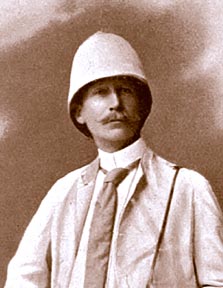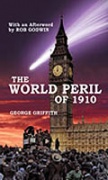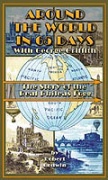George Chetwynd Griffith
From The Space Library
 George Griffith circa 1900 | |
| Birth Name | George Chetwynd Griffith Jones |
|---|---|
| Birth Date | 20th August 1857 |
| Birth Place | Plymouth, Hampshire, England |
| Date of Death | 4th June 1906 |
| Place of Death | Port Erin, Isle of Man |
| Occupation | Novelist, Teacher, Historian, Journalist |
| Nationality | British |
| Notable Works | The Angel of the Revolution, Olga Romanoff, The World Peril of 1910, Outlaws of the Air, A Honeymoon in Space, Valdar the Oft Born |
Contents |
Early Life
George Chetwynd Griffith Jones was born in 1857 in Plymouth England. His father, George Alfred Jones, a cleric, had little money at his death, but had provided young George with access to his extensive library, which included the fantastic works of Jules Verne.
Griffith spent a good portion of his youth travelling around the world and at one point he described himself in Who’s Who thus, “Sea apprentice; sundowner; sailor; stock-rider; butcher; globe-trotter; schoolmaster; journalist and story-writer.” His recreational pursuits included, “Loafing, travelling and sailing.”
By the time H.G. Wells was only five years old, George Griffith had sailed around the world three times, including three passes around Cape Horn. On retiring as a seaman, he returned to England and spent several years working as a teacher in the north of England, even though he had never successfully completed his own education. Later, while teaching in Brighton, he began writing for the local newspaper. It was at this time that publisher Cyril Pearson hired Griffith, who was down on his luck and short of money. Griffith was initially employed to answer the mail and to give trite answers to reader’s questions about everything from wines to writing. By the time he settled into his job as a mail-clerk and general gopher at Pearson’s, he had a well-rounded self taught background. Griffith was soon to become firmly ensconced in the world of popular magazines. As a correspondent he crossed the Rockies as well as the Andes (three times).
Griffith would drop his surname "Jones" because he claimed "No one famous was ever called Jones."
Science Fiction
In 1897 Griffith would visit the subject of planetary collisions in his short story The Great Crellin Comet. It would be first published in Pearsons Weekly’s Christmas Annual of November 1897. It is perhaps worth noting that this story appeared about three weeks before H.G. Wells comet story The Star appeared in London’s Graphic Weekly.
The next time Griffith would turn his talents towards space would be for another serial which ran in Pearson’s Magazine from January to June 1900. He wrote it while on one of his many foreign exploits, this time in Australia in late 1899. It was called Stories of Other Worlds and the installment titles were, A Visit to the Moon, The World of the War God, A Glimpse of the Sinless Star, The World of the Crystal Cities, In Saturn’s Realm and Homeward Bound. It was first published at least five months before Wells’ First Men in the Moon. Griffith sent his protagonists out into space not to merely visit the moon, but his was a full-fledged expedition of space tourism. He later expanded the story and it was published by Pearson’s as a novel in 1901 retitled “A Honeymoon in Space.”
Books by George Griffith
Buy This Book Click here |
Buy This Book Click here |
|
|
|
|
Critical Appraisal
George Griffith is a mostly forgotten titan of his era. Part of the reason for this oversight undoubtedly rests in the fact that his publisher, Tower of London, went bankrupt in June of 1896. By October of that year Griffith found himself in court in London trying to stop the receivers from liquidating his copyrights. Ultimately he won the battle (and set a legal precedent doing so) but it was costly and time consuming and in the meantime it left him with no publisher for his most successful early works, the two Romanoff novels and Outlaws of the Air.
Scholars of science fiction have placed little importance on Griffith’s works, especially when compared to his more famous counterpart H.G. Wells. Griffith was intent on telling a good story and he took some pains to make sure that the speculation and technology were as up-to-date as he could manage, while Wells instructed his readers in sociology, using moralistic fables. The few scholars who mention Griffith dismiss him by saying he was unimaginative and that he did little but co-opt the ideas of Wells, Camille Flammarion and others. The Flammarion connection is clearly acknowledged by Griffith, but the idea of cometary collision dated back at least as far as Edmond Halley and it seems that Griffith’s story is very probably the first to recognize the danger represented by the kinetic energy in a cometary collision.
It also seems difficult to place any credence on the insinuation that Griffith stole from Wells. Griffith preempted Wells with a Mars story (Olga Romanoff), a space voyage (A Honeymoon in Space), a comet story (The Great Crellin Comet), an aerial warfare story (Outlaws of the Air) and even his time travel story (Valdar the Oft-Born) was published before Wells adapted his Chronic Argonauts into the bestseller The Time Machine.
Later Life
After terminating his long relationship with Cyril Pearson, Griffith corresponded for the Daily Mail from South Africa, a location where he had set a future war story about the British versus the Boers, written before the war began. His story Hellville USA was about a town-sized penal colony, quarantined from the rest of America; a concept taken to its ultimate conclusion in the hugely successful John Carpenter movie Escape from New York almost a century later. Master novelist Michael Moorcock would later call Griffith “the first professional science fiction writer” because he produced story after story, on demand, for his editors and publishers.
George Griffith's son was Alan Arnold Griffith, chief engineer at the Royal Aircraft Establishment and later at Rolls Royce. A.A. Griffith is credited with having invented the axial compressor for jet engines and is widely credited as being the father of VTOL aircraft through his oversight of the Rolls Royce XJ-314 experimental thrust measuring rig, or the Flying Bedstead.


